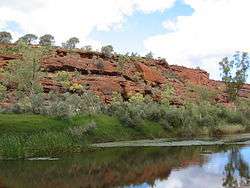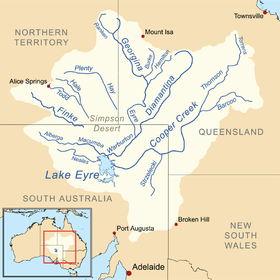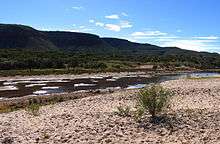Finke River
The Finke River, or Larapinta (Arrernte), is a river in central Australia, one of four main rivers of the Lake Eyre Basin and thought to be the oldest riverbed in the world. It flows for only a few days a year and when this happens, its water usually disappears into the sands of the Simpson Desert, rarely if ever reaching Lake Eyre.
| Finke | |
|---|---|
 The Finke River after rain, Northern Territory | |
 Map of the Lake Eyre Basin showing the Finke River | |
| Etymology | William Finke |
| Native name | Larapinta[1] |
| Location | |
| Country | Australia |
| State | Northern Territory, South Australia |
| Physical characteristics | |
| Length | 750 km (470 mi) |
| Basin features | |
| River system | Lake Eyre Basin |
| National parks | West MacDonnell; Finke Gorge |
| [2] | |
Geography
The source of the Finke River is in the Northern Territory's MacDonnell Ranges, and the name Finke River is first applied at the confluence of the Davenport and Ormiston Creeks, just north of Mount Zeil.[3] From here the river meanders for approximately 600 km (370 mi) to the western edge of the Simpson Desert in northern South Australia.[4] It flows through the West MacDonnell and Finke Gorge National Parks.
Usually the river is a string of waterholes, but it can become a raging torrent during rare flood events. In extreme events, water from the Finke River flows into the Macumba River, which empties into Lake Eyre, a total distance from headwater streams of around 750 km (470 mi). Major tributaries include Ellery Creek, and the Palmer and Hugh Rivers.
History
Wangkangurru (also known as Arabana/Wangkangurru, Wangganguru, Wanggangurru, Wongkangurru) is an Australian Aboriginal language spoken on Wangkangurru country. It is closely related to Arabana language of South Australia. The Wangkangurru language region was traditionally in the South Australian-Queensland border region taking in Birdsville and extending south towards Innamincka and Lake Eyre, including the local government areas of the Shire of Diamantina as well as the Outback Communities Authority of South Australia.[5]
Names

The Finke River was named by John McDouall Stuart in 1860 after an Adelaide man, William Finke, who was one of the promoters of his expedition.[6]
The Indigenous name for the river in parts of the Northern Territory, usually taken as Larapinta, may have been incorrectly translated by its first transcriber, the explorer Ernest Giles. In August 1872, while camped at Charlotte Waters Telegraph Station, Giles was the first "outsider" to record the Arrernte name for the Finke River. He incorrectly deduced from his conversations with Southern Arrernte that the name was derived from the gigantic mythological snake (known as the Rainbow Serpent) which was believed to have created the river, and thought that larapinta meant snake in the local language. However in July 1876, Rev. Georg A. Heidenreich, the Superintendent of the Finke River Mission Station,[7][8] appears to have been the first to have confirmed the Western Arrernte name of the river, which was actually "Lara Beinta", which means "Salt River". This translation is now widely accepted because the Finke contains certain waterholes that are constantly salty (one of which is named "Salt Hole" in English). The legend of its derivation from the serpent is nonetheless held by the local people.[9]
The original spelling was a deliberate choice used for the main exit road west from Alice Springs, Larapinta Drive, as it leads to the Finke River at Hermannsburg;[7][1] the name was also used for an Alice Springs suburb and the Larapinta Trail. (Larapinta, Queensland may have a different derivation.)
Antiquity of the Finke River
The Finke River is frequently cited as the oldest river in the world.[10][11] Its age has been deduced from observation and analysis of various factors in the geology of the area. In places such as the James Range, the Finke flows through deeply incised meanders.[12][13] Because meanders only form on flat plains, the river must have formed before the ranges were pushed up; this happened in a mountain building event referred to as the Alice Springs Orogeny which peaked between 400 and 300 million years ago (Devonian to Carboniferous Periods, both within the Paleozoic Era).[14][15] It is not possible to say with absolute confidence that it is the very oldest river, but it is certainly one of the oldest rivers in the world.[16]
However, southern parts of its course must be much younger, because the areas where the Finke now flows near the southern edge of the Northern Territory, and further south, were under the sea during the Mesozoic Era,[14] part of the Great Artesian Basin.
The antiquity of the Finke River is not unique, but applies equally to other large mountain-sourced river systems in central Australia, such as the Todd and Hale Rivers and many others, because most of the central Australian mountain belts formed at around the same time.[17] There are other eroded mountain ranges of equal or greater age to the MacDonnell Ranges, both in Australia and on other continents, so present rivers in those areas may have evolved from ancestral streams of equal and greater antiquity than the Finke.
See also
References
- "Larapinta". Northern Territory Place Names Register. Retrieved 1 October 2007.
- "Map of Finke River, NT". Bonzle Digital Atlas of Australia. Retrieved 23 March 2017.
- Google Maps image
- Google Maps image
-

- Finke River: Northern Territory Place Names Register (accessed 1 October 2007)
- "The Finke River Mission Station". Trove. South Australian Register. 26 January 1886. Retrieved 15 May 2019.
- "Our history". Finke River Mission. Retrieved 16 May 2019.
- Kimber, Richard (2009). "Chapter 13. Placenames of central Australia: Early European records and recent experience". In Harold Koch; Luise Hercus (eds.). Aboriginal Placenames: Naming and re-naming the Australian landscape. Aboriginal History Monograph. Australian National University. Aboriginal History Incorporated. p. 23. ISBN 9781921666087. Retrieved 15 May 2019.
- "Oldest rivers in the world". Oldest.org. Retrieved 16 May 2019.
- Gilles, Shakes (11 May 2018). "The oldest river in the world". Retrieved 16 May 2019.
- Pickup G, Allan G, Baker VR (1988). Warner RF (ed.). "History, palaeochannels and palaeofloods of the Finke River, central Australia". Fluvial Geomorphology of Australia. London: Academic Press: 177–200.
- See Google Maps image
- Wells AT, Forman DJ, Ranford LC, Cook PJ (1970). "Geology of the Amadeus Basin, Central Australia". Bureau of Mineral Resources, Australia, Bulletin. 100.
- Haines PW, Hand M, Sandiford M (2001). "Palaeozoic synorogenic sedimentation in central and northern Australia: a review of distribution and timing with implications for the evolution of intracontinental orogens". Australian Journal of Earth Sciences. 48 (6): 911–928. doi:10.1046/j.1440-0952.2001.00909.x. Abstract
- "Australian landforms and their history". Australian Government. Geoscience Australia. Retrieved 16 May 2019.
- Mabbutt JA (1967). Jennings JN, Mabbutt JA (eds.). "Denudation chronology in central Australia: Structure, climate and landform inheritance in the Alice Springs area". Landform Studies from Australia and New Guinea. Canberra: Australian National University Press: 144–181.